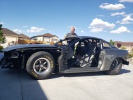Hello,
I am hoping someone can lead me in the right direction. I have been chasing a rough idle (at warmup), lean tip in (under certain conditions), and constant raw fuel smell. To complicate things a bit more, this is on an 0411 swap I did to a big block. I've got 100+ flashes to the ECU and once warm the car runs fantastic other than the lean tip in (occasionally) and the horrible raw fuel smell. After a lot of research I have narrowed the issue down to what I believe to be EOIT. I have been pretty fortunate to have grasped just about all the concepts on google and HPT forum. This just seems to be something that is not clicking, I'm honestly lost. I read the 25+ Page dissertation in regard to it on here, but honestly it left me more confused than anything else. To complicate this a little more, I am using a 0411 ECU with a 02 Suburban 5.3 tune file that has been revamped to run the older style big block. So I was able to draw the conclusion that there is an issue based on a comparison of both tune files. I am going to post below all of the information I have accumulated. I am hoping someone can point me to a definitive conclusion as to how to set these two tables or better yet a set of guidelines to use when calculating this and setting the tables for this in the future. I think part of the problem is, there seems to be more GEN 4 information on this topic than GEN 3, and the information seems to flow together in a way that makes it harder to understand. Or I'm just not that smart, that's very likely as well. Hopefully this thread will serve the purpose of outlining some sort of process for those seeking to fix the same in the future.
Current File Settings - Pretty generic for most GEN 3 4.8, 5.3, 6.0 SB
EOIT Gen 3.JPG
This is a screen shot of the stock settings removed from a Vortec 7400 which would closely resemble my engine if NOT for the cam
EOIT 454.JPG
This is a copy of the specifications of the Cam used from Comp (Part#11-423-8 XR27HR-10)
Cam Card 454.JPG
Here is a copy of the cam card from the engine builder. It appears as though he advanced it .25 degrees from the centerline
21324-MMS-1546447949375-attachment1-20190102_115030-1.jpg
I believe this is what really confused the heck out of me. This seems like a great comprehensive tool, but unfortunately I can't seem to put it together. This was removed from an HPT forum thread that was posted in Feb of 2018. I don't know who to credit it to, but as you can surmise from my lack of understanding it, I sure as hell didn't create it.
DWR SOIT EOIT Worksheet 041715 (1).xls
-Dan




 Reply With Quote
Reply With Quote
